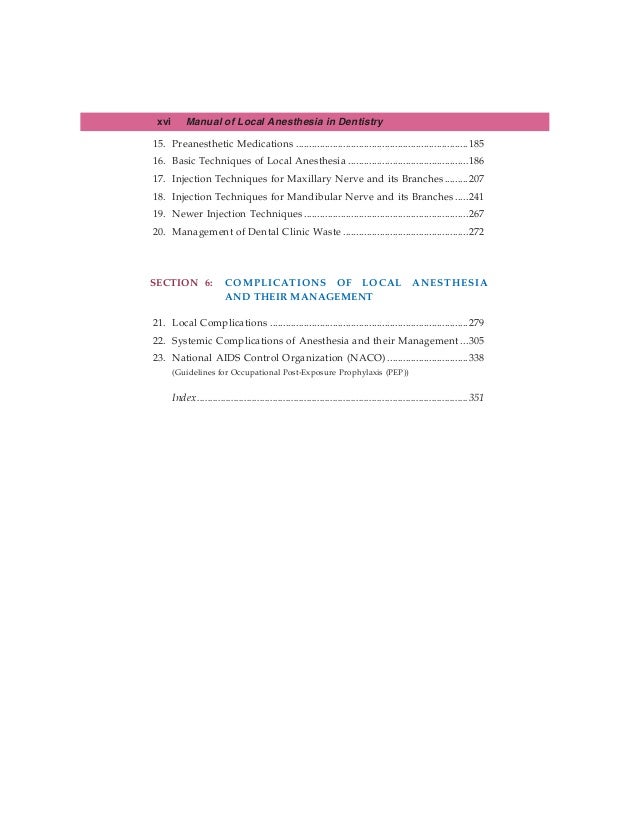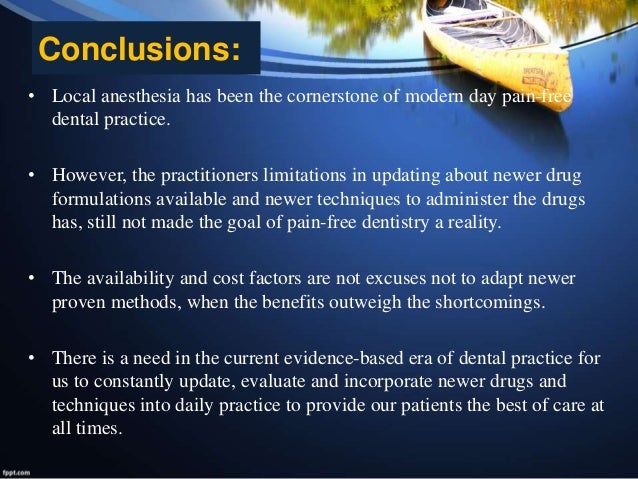An Update On Local Anesthetics In Dentistry

Complications following local anaesthesia - Den norske tannlegeforenings Tidende. Nor Tannlegeforen Tid 2. Johanna S. Normally, the effect is achieved and no adverse effects are seen. However, complications, even very serious ones, can occur in daily practice.

Complications related to local anesthesia can be divided into two categories: peroperative and postoperative complications. Both can usually be be avoided by using the correct technique and dosage.
Dentistry Today is The Nations Leading Clinical News Magazine for Dentists?
Local anesthetics reduce pain, thereby facilitating surgical procedures.
- The American Academy of Pediatric Dentistry, AAPD, is the authority on children’s oral health and dental care.
- Dentistry for the Disabled Child and Adult I. INTRODUCTION. FINDING A GOOD DENTIST FOR YOUR DISABLED CHILD/ADULT. LEVELS OF ANESTHESIA TO CONTROL BEHAVIOR.
- No other journal can match Anesthesia & Analgesia for its original and significant contributions to the anesthesiology field. Each monthly issue features peer.
- Administration of local anesthetics is daily routine for most dental practitioners. Normally, the effect is achieved and no adverse effects are seen.
- Mepivacaine is an anesthetic (numbing medicine) that blocks the nerve impulses that send pain signals to your brain. Mepivacaine is used as a local (in only one area.
- This is achieved by.
- The physiological effects of aging, as well as possible polypharmacy, make elderly patients more susceptible to adverse reactions to and interactions with the.
However, if complications occur, the dentist should know how best to manage them. In this review the most common complications are presented. The preventive measures as well as treatment possibilities are also shortly described. In this review we present the most common peroperative and postoperative complications in local anaesthesia, as well as preventive measures and treatment possibilities. Peroperative complications.
Needle breakage. Needle breakage during local anaesthesia is becoming a less common complication than it was a few years ago. This is due to a larger awareness of the possible causes and methods for avoiding such complications. Reasons for needle breakage can be categorized into six different groups: weakness of the alloy,narrowness of the needle,reusage of the needle,incorrect technique,sudden movement of the patient (1) or practitioner, andmanufacturing defects (2).
Metal alloys used nowadays in injection needles are flexible, stainless and more durable than previously. This has decreased the number of needle breakages, but has not entirely solved the problem.
Flexibility and narrowness allow the needle to be penetrated softly into the tissue; however the needle can breake more easily when bent or otherwise used incorrectly (3). Reusage of needles among different patients should be history in contemporary dentistry; yet, this may happen during the same appointment when giving additional dosages of anaesthetics to the same patient. Repeated injections with the same needle cause fatigue of the structure and the risk of needle fracture increases (4).
The practitioner should be careful and always check all needles for any deformations before injection. False techniques include aggressive insertion of a needle into the tissue, sudden changes in the direction inside the tissue or a too deep penetration, all of which may lead to a broken hypodermic needle. If the needle goes up to its hub inside the tissue before getting bone contact, the dentist should check if the injection site is correct and the needle is long enough for achieving the target nerve. The hub is the most common point of needle fracture. It is important to know adequate techniques for different areas in the mouth to be able to inject without bending the needle and inserting it too deep. Aggressive movements and change of direction creates forces against the needle from its sides and can lead to a sudden breaking. Any movement that causes needle deflection should be avoided.
Aggressive insertion can lead to sudden movements of the patient making the dentist unable to control the movements of the needle (1,3 – 5). Manufacturing defects seldom happens. Cara Membuat Form Upload File Dengan Php Insurance.
However, they still do occur, and with large manufacturing lots of defects are unavoidable. Dentists should always check all the instruments, also the injection needles, before using them. If there is any suspicion of inadequate product quality a new one should be used. What to do when the needle breaks? Tell the patient what has happened and try to relax and comfort him/her. Stabilise the patient’s jaws so that he/she cannot move them in order that the needle fragment stays in place.
If the patient moves the jaws and the muscles of the masticatory system, the tension of the tissues is released and the needle continues to penetrate the tissues and thus may cause pain (3). Movement of the needle fragment can cause trismus if impacted into muscles attaching to the styloid process. It would be useful to have a pair of forceps at hand if needed (3,4). If possible try to take radiographs of the suspicious area.
If you cannot remove the broken part yourself, refer the patient to the closest department of oral and maxillofacial surgery with possible radiographs and a report about the complication and how you tried to treat it. Be sure to inform the patient accordingly. In the department of oral and maxillofacial surgery the patient is examined and the needle is removed surgically under general anaesthesia. This will provide complete immobility and muscle relaxation. Methods used to localise a hypodermic needle fragment are 3- D CT- scans, metal detectors, stereotactic techniques with guided needles, electromagnets and ultrasonographies (1,2,5).
Antibiotics, analgesics and careful oral hygiene are indicated postoperatively (2). Pain at injection.
Pain during administration of the local anaesthetic solution can be caused by many reasons. Factorsdepending on the solution are low p. H- value that may irritate the tissue, and the temperature of the solution – warmer feeling more comfortable than cold. The cartridge can be warmed in the practitioners hand or in warm water before injection (6).
The practitioner- related factors relate to the technique used. Fast injections and high injection pressures cause rapid swelling of the tissue and pain.
This can be avoided only by a slower injection. Aggressive insertion of the needle can tear soft tissues, blood vessels, nerves or periosteum and cause more pain and other complications. An inadequate injection site can lead to an intramuscular or intraneural injection. When the needle penetrates a nerve, the patient feels a sudden «electric shock» in the distal area of the nerve.
Pain after intramuscular injection is due to fibrosis or inflammation inside the muscle (7). Hypersensitivity and allergy. Hypersensitivity or allergy to local anaesthetic is very rare. It is estimated that less than 1 % of all complications are caused by allergy (8,9). Many of the complications suspected to be allergic are actually psychogenic reactions caused by fear of dental treatment. Another reason may also be the presence of adrenaline in local anaesthetic which can cause several general symptoms, including palpitation. Naturally, sometimes a patient may suffer from an allergic reaction.
In such cases the allergen is usually an additive, for example bisulphite or paraben, which is used as preservative in injectable local anaesthetic formulation. Latex may also be a potential allergen. Some of the anaesthetic cartridges have latex rubber stoppers. During injection, latex can be released from stoppers and hence cause an allergic reaction to latex- hypersensitive person (1.
Allergic reactions vary from a mild skin irritation or rash to an anaphylactic shock. The main signs and symptoms of anaphylactic shock are chest discomfort, urticaria, stomach pain and dyspnoea. An anaphylactic reaction can rapidly lead to a life- threatening condition due to airway passage obstruction in association with laryngeal oedema (1.
Therefore, it has to be treated immediately. If such complications are observed, it is very important to determine its actual cause. Inadequate diagnosis and treatment can be life- threatening to the patient. Skin or intra- oral tests can be used to find a real allergen and help the patient in avoiding exposures to those agents (1. Overdosage and toxicity. Local anaesthetic toxicity in dental practice is rare. A toxic reaction can occur when the concentration of local anaesthetic in circulation increases too rapidly.
When injecting into a highly vascular area there is a risk of an intravenous injection. In addition, overdosage may lead to intoxication (1. The toxic effect is primarily directed to the central nervous system and cardiovascular system. Typical symptoms are restlessness, convulsion and loss of consciousness. More severe symptoms can be coma, respiratory arrest, increase in blood pressure and heart rate and even vascular collapse and cardiac arrest (1.